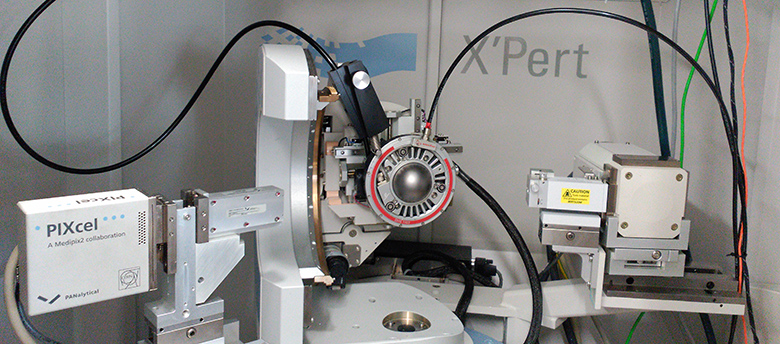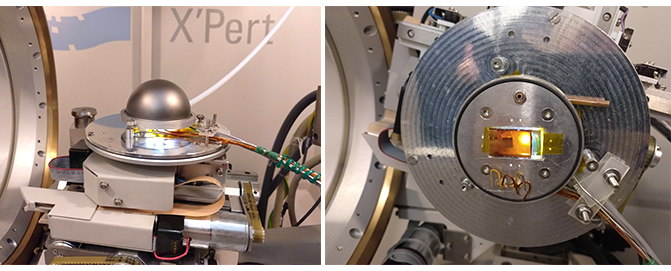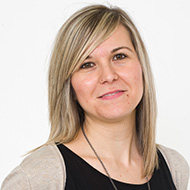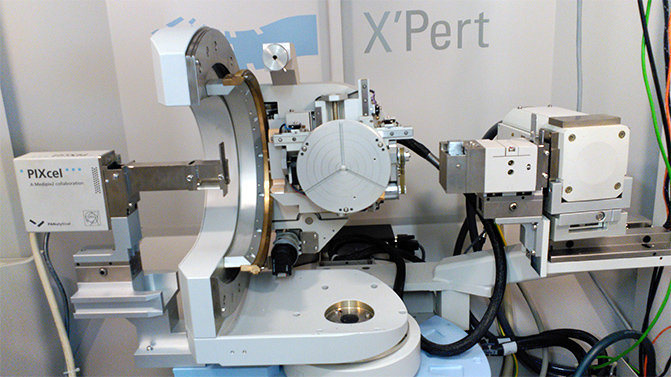Malvern PANalytical X’pert Pro MRD
The MRD (Materials Research Diffractometer) is suitable for the structural characterization in thin-films materials at room and high temperature. This diffractometer has a horizontal ω-2θ goniometer (320 mm radius) in a four-circle geometry and it works with a ceramic X-ray tube with Κα anode (λ=1.540 Å). This diffractometer is equipped with different incident and diffracted optics which can be interchanged depending on the application required (i.e. a parabolic mirror, a hybrid monochromator, a Ge(440) four-crystal monochromator, a parallel plate collimator, and a polycapillary lens). The detector used is a PIXcel which is a fast X-ray detector based on Medipix2 technology with a 256x256 pixels array.
Technical specifications
- X-ray source: Cu Κα radiation (Κα = 1.54187 Å)
- Goniometer radius: 320 mm
- Geometry: Four-circle geometry (ω-2θ system, horizontal goniometer)
- Scan range of 2θ: 3°-150°
- Minimum-Maximum step size: 0.001°-1.27°
- Incident PreFIX Module: Parabolic Mirror for Cu Kα radiation
Hybrid Monochromator
Ge(440) four-crystal monochromator
Polycapillary lens - Diffracted PreFIX Module: Rocking curve
Parallel Collimator - Detector: PIXcel Detector
- Temperature chamber: Anton Paar DHS 1100 Dome hot stage
- Available Software: X’pert Data Collector, X’pert Data Viewer, X’pert Epitaxy, X’pert Reflectivity, X’pert Texture, X’pert Highscore
High-resolution XRD routine applications
- Crystal structure analysis: phase identification, determination of cell parameters, domain orientation and stress on thin films.
- θ-2θ measurements (normal and high resolution) in epitaxial and polycrystalline thin-films.
- X-ray Reflectivity measurements for estimation of thickness and roughness.
- Rocking curves measurements.
- Reciprocal Space Mappings.
- Texture analysis (Phi and pole figures measurements).
- Grazing incidence measurements.


Non ambient XRD at MRD
Apart from the routine measurements at Room Temperature, there is the possibility to carry out XRD measurements in non-ambient conditions. Two different kind of chambers are available in the XRD Facility (under request):
- Non-ambient Chamber Anton Paar DHS 1100 (commercial)
- Non-ambient Chamber to apply illumination and temperature (Designed in-house)
High-resolution XRD unconventional applications
- In-plane reciprocal space mappings (grazing incidence and grazing exit).
- Temperature-dependent reciprocal space mappings (at standard Bragg-Brentano and in-plane configuration).
- In-situ thin films characterization applying:
- Gas exchanges at elevated temperatures (redox kinetics, oxide ionic materials).
- Applied voltage bias (piezoelectric, ferroelectric, electrostriction, resistive switching).
- Exchange between wet and dry atmosphere (water uptake, protonic conducting materials).
- Simultaneous atmosphere exchange and electrical conductivity.
- LED illumination at RT and applying temperature (photo-activated phase transitions, photostriction or ageint studies…)
Non-ambient chamber Anton Paar DHS 1100
The Anton Paar DHS 1100 Dome hot stage can be mounted for temperature-induced phase transitions investigations, texture measurements, and stress analysis at high temperatures. The dome-shaped X-ray window made of graphite allows analysing samples under atmosphere control (air, vacuum, and inert gas) to avoid oxidation or other chemical reactions of thin films at up 1100°C.
Technical specifications Anton Paar DHS 1100
- Operating temperature range: 25°C-1100°C
- Heating rate: Max. 500°C/min
- Atmospheres: Air, inert gases, N2, 2% O2, vacuum (10-2 mbar)
- Max. operating pressure: 0.3 bar above atmospheric pressure
- X-ray geometry: Reflection
- Sample-holder material: Aluminium nitride
- X-ray material window (DOME): Graphite
- Sample fixing springs: Inconel
- Heater: Kanthal
- Thermocouple: Pt-Pt10Rh

Non-ambient chamber LED + Temperature
MRD is also equipped with a new LED sample stage which can be easily mounted in the MRD Cradle platform to perform in-situ XRD experiments under constant illumination, temperature and different atmospheres (N2, air, inert gases). Two different LED’s are available in the system. One is for UV light (380 nm) and the other one a High Visible LED. This chamber is also designed to perform electrical measurements simultaneously with XRD.
Technical specifications LED + temperature chamber
- Operating temperature range: 25°C-150°C
- Heating rate: Max. 1°C/min
- Atmospheres: Air, inert gases, N2, 2% O2
- X-ray geometry: Reflection
- UV High power LED: λ= 380nm, radiation = 200-300mW
- High Visible power LED: λ= 150-170nm, radiation = 3W
- X-ray material window (DOME): Graphite

Contact
-
 Jessica Padilla Pantoja
Jessica Padilla Pantoja
Research Technician of the X-ray Diffraction Facilities
jessica.padilla(ELIMINAR)@icn2.cat
Tel. +34937372638
Associated Groups/Units


